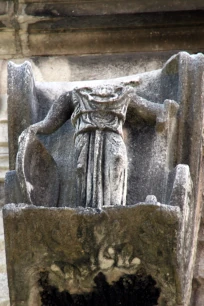The Arch of Janus is an ancient marble arch built in the fourth century AD during the reign of Emperor Constantine I. The arch, situated at the border of the Forum Boarium, has four gates and was built over the intersection of two roads.


During the heyday of the Roman Empire, triumphal arches such as the Arch of Septimius Severus and the Arch of Titus were built to celebrate the victories of the Roman army. In contrast, the Arch of Janus was built for a very practical purpose: it was a meeting point for the merchants of the cattle market at the Forum Boarium. The arch provided cover against the sun and rain.


The Arch
The massive marble arch was built with material from older Roman ruins. The two rows of niches once contained statues. The four keystones are decorated with reliefs of ancient goddesses. They depict Minerva and Ceres (standing) and Roma and Juno (seated).
In the Middle Ages, the Frangipani family used the monument as the base for a fortified tower. The tower was demolished in 1827. Unfortunately, during the demolishment, the original attic of the arch was accidentally removed. Parts of the inscriptions that decorated the attic can now be found in the nearby church of San Giorgio in Velabro.
Janus Quadrifrons
The full name of the arch is Arch of Janus Quadrifrons. The arch was long thought to be a temple dedicated to the Roman God Janus (Ianus in Latin), who was known as the god who opened the gate to heaven. He also represented beginning and end, which explains why he is often represented with two faces. The month January is named after him, as is the Latin name for a door or gate (ianua).
Janus is also sometimes depicted with four faces, hence the term Quadrifrons (from Latin, loosely meaning four fronts). On the Ponte Fabricio at the Tiber Island, just a stone’s thrown away, you can see two herms (pillars with heads) with the four-faced head of Janus. The four arched passages of the Arch of Janus were seen as a reference to the four-faced Janus, which explains why it was assumed that the arch was dedicated to this particular Roman god.
- Next: Curia
- More Rome Ancient Sights
- More Sights & Attractions in Rome

